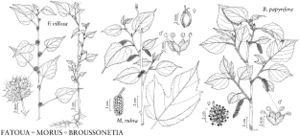Difference between revisions of "Morus rubra"
Sp. Pl. 2: 986. 1753.
FNA>Volume Importer |
imported>Volume Importer |
||
| (6 intermediate revisions by 2 users not shown) | |||
| Line 9: | Line 9: | ||
|common_names=Red mulberry;mûrier rouge;moral | |common_names=Red mulberry;mûrier rouge;moral | ||
|special_status={{Treatment/ID/Special_status | |special_status={{Treatment/ID/Special_status | ||
| + | |code=W1 | ||
| + | |label= | ||
| + | }}{{Treatment/ID/Special_status | ||
|code=E | |code=E | ||
|label=Endemic | |label=Endemic | ||
}}{{Treatment/ID/Special_status | }}{{Treatment/ID/Special_status | ||
|code=F | |code=F | ||
| − | |label= | + | |label=Illustrated |
| − | |||
| − | |||
| − | |||
}} | }} | ||
|basionyms= | |basionyms= | ||
|synonyms={{Treatment/ID/Synonym | |synonyms={{Treatment/ID/Synonym | ||
| − | |name= | + | |name=Morus rubra var. tomentosa |
|authority=(Rafinesque) Bureau | |authority=(Rafinesque) Bureau | ||
| + | |rank=variety | ||
}} | }} | ||
|hierarchy=Moraceae;Morus;Morus rubra | |hierarchy=Moraceae;Morus;Morus rubra | ||
| Line 37: | Line 38: | ||
|elevation=0-300 m | |elevation=0-300 m | ||
|distribution=Ont.;Ala.;Ark.;Conn.;D.C.;Fla.;Ga.;Ill.;Ind.;Iowa;Kans.;Ky.;La.;Md.;Mass.;Mich.;Minn.;Miss.;Mo.;Nebr.;N.J.;N.Y.;N.C.;Ohio;Okla.;Pa.;S.C.;Tenn.;Tex.;Vt.;Va.;W.Va.;Wis. | |distribution=Ont.;Ala.;Ark.;Conn.;D.C.;Fla.;Ga.;Ill.;Ind.;Iowa;Kans.;Ky.;La.;Md.;Mass.;Mich.;Minn.;Miss.;Mo.;Nebr.;N.J.;N.Y.;N.C.;Ohio;Okla.;Pa.;S.C.;Tenn.;Tex.;Vt.;Va.;W.Va.;Wis. | ||
| − | |discussion=<p>Morus rubra is sporadically established along fencerows in southern New Mexico (R. Spellenberg, pers. comm.). Rhode Island is in the range of Morus rubra, although I do not know of any documented specimens.</p><!-- | + | |discussion=<p><i>Morus rubra</i> is sporadically established along fencerows in southern New Mexico (R. Spellenberg, pers. comm.). Rhode Island is in the range of <i>Morus rubra</i>, although I do not know of any documented specimens.</p><!-- |
| − | --><p>Morus rubra is a common tree of eastern North America. The leaves are highly variable, often with deeply lobed and entire leaves on the same plant. The abaxial surface of the leaf varies from sparsely to densely pubescent.</p><!-- | + | --><p><i>Morus rubra</i> is a common tree of eastern North America. The leaves are highly variable, often with deeply lobed and entire leaves on the same plant. The abaxial surface of the leaf varies from sparsely to densely pubescent.</p><!-- |
| − | --><p>According to D. E. Moerman (1986), Native American tribes used infusions of the bark of Morus rubra medicinally to check dysentery, as a laxative, and as a purgative; infusions of the root for weakness and urinary problems; and tree sap rubbed directly on the skin as treatment for ringworm.</p> | + | --><p>According to D. E. Moerman (1986), Native American tribes used infusions of the bark of <i>Morus rubra</i> medicinally to check dysentery, as a laxative, and as a purgative; infusions of the root for weakness and urinary problems; and tree sap rubbed directly on the skin as treatment for ringworm.</p> |
|tables= | |tables= | ||
|references= | |references= | ||
| Line 48: | Line 49: | ||
-->{{#Taxon: | -->{{#Taxon: | ||
name=Morus rubra | name=Morus rubra | ||
| − | |||
|authority=Linnaeus | |authority=Linnaeus | ||
|rank=species | |rank=species | ||
|parent rank=genus | |parent rank=genus | ||
| − | |synonyms= | + | |synonyms=Morus rubra var. tomentosa |
|basionyms= | |basionyms= | ||
|family=Moraceae | |family=Moraceae | ||
| Line 62: | Line 62: | ||
|publication title=Sp. Pl. | |publication title=Sp. Pl. | ||
|publication year=1753 | |publication year=1753 | ||
| − | |special status=Endemic; | + | |special status=W1;Endemic;Illustrated |
| − | |source xml=https:// | + | |source xml=https://bitbucket.org/aafc-mbb/fna-data-curation/src/2e0870ddd59836b60bcf96646a41e87ea5a5943a/coarse_grained_fna_xml/V3/V3_154.xml |
|genus=Morus | |genus=Morus | ||
|species=Morus rubra | |species=Morus rubra | ||
Latest revision as of 21:46, 5 November 2020
Shrubs or trees, to 20 m. Bark gray-brown with orange tint, furrows shallow, ridges flat, broad. Branchlets red-brown to light greenish brown, glabrous or with a few trichomes; lenticels light colored, elliptic, prominent. Buds ovoid, slightly compressed, 3-7 mm, apex acute; outer scales dark brown, often pubescent and minutely ciliate; leaf scars oval to irregularly circular, bundle scars numerous, in circle. Leaves: stipules linear, 10-13 mm, thin, pubescent; petiole 2-2.5 cm, glabrous or pubescent. Leaf blade broadly ovate, sometimes irregularly lobed, 10-18(-36) × 8-12(-15.5) cm, base rounded to nearly cordate, sometimes oblique, margins serrate or crenate, apex abruptly acuminate; surfaces abaxially sparsely to densely pubescent or puberulent, adaxially with short, antrorsely appressed trichomes, usually scabrous. Catkins: peduncle pubescent; staminate catkins 3-5 cm; pistillate catkins 8-12 × 5-7 mm. Flowers: staminate and pistillate on different plants. Staminate flowers: sepals connate at base, green tinged with red, 2-2.5 mm, pubescent outside, ciliate toward tip; stamens 4; filaments 3-3.5 mm. Pistillate flowers: calyx tightly surrounding ovary; ovary green, broadly ellipsoid or obovoid, slightly compressed, 1.5-2 × 1 mm, glabrous; style branches divergent, whitish, sessile, ca. 1.5 mm; stigma papillose. Syncarps black or deep purple, cylindric, (1.5-)2.5-4(-6) × 1 cm; fleshy calyx surrounding achenes; achenes yellowish, oval, flattened, ca. 2 mm, smooth.
Phenology: Flowering spring–summer.
Habitat: Moist forests and thickets
Elevation: 0-300 m
Distribution

Ont., Ala., Ark., Conn., D.C., Fla., Ga., Ill., Ind., Iowa, Kans., Ky., La., Md., Mass., Mich., Minn., Miss., Mo., Nebr., N.J., N.Y., N.C., Ohio, Okla., Pa., S.C., Tenn., Tex., Vt., Va., W.Va., Wis.
Discussion
Morus rubra is sporadically established along fencerows in southern New Mexico (R. Spellenberg, pers. comm.). Rhode Island is in the range of Morus rubra, although I do not know of any documented specimens.
Morus rubra is a common tree of eastern North America. The leaves are highly variable, often with deeply lobed and entire leaves on the same plant. The abaxial surface of the leaf varies from sparsely to densely pubescent.
According to D. E. Moerman (1986), Native American tribes used infusions of the bark of Morus rubra medicinally to check dysentery, as a laxative, and as a purgative; infusions of the root for weakness and urinary problems; and tree sap rubbed directly on the skin as treatment for ringworm.
Selected References
None.
